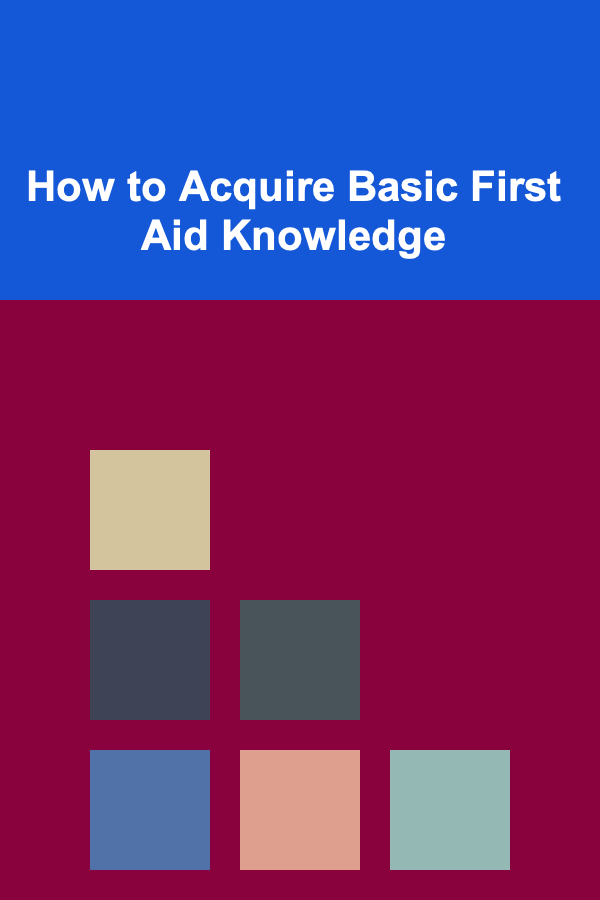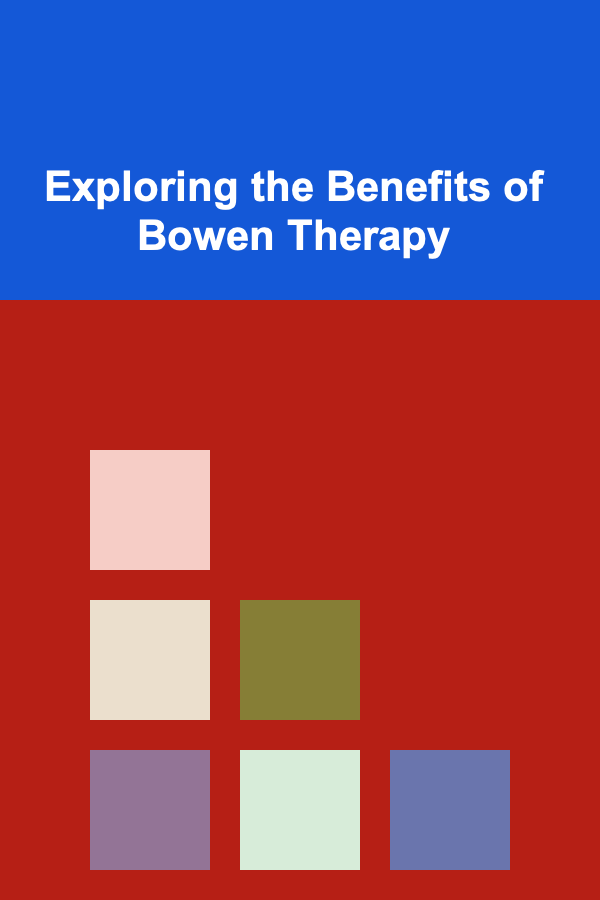
How to Acquire Basic First Aid Knowledge
ebook include PDF & Audio bundle (Micro Guide)
$12.99$7.99
Limited Time Offer! Order within the next:

First aid is an essential skill that everyone should acquire. It could mean the difference between life and death in emergency situations, and even in less critical situations, it can provide comfort and help until professional medical assistance arrives. While no one can predict when an emergency might occur, being prepared with basic first aid knowledge is always a wise decision.
In this article, we will delve into the steps to acquiring basic first aid knowledge, its importance, and how you can apply it effectively in real-life situations. By the end, you will have a comprehensive understanding of the fundamentals of first aid and how to use it when necessary.
The Importance of First Aid Knowledge
Before we dive into how to acquire first aid knowledge, it's essential to understand why this skill is so crucial. First aid knowledge allows individuals to manage medical emergencies in the critical minutes before professional help arrives. This could include a range of situations, such as:
- Cardiac Arrest: Knowing how to perform CPR (Cardiopulmonary Resuscitation) can save a life.
- Wounds and Bleeding: Stopping bleeding and preventing infection.
- Fractures and Sprains: Knowing how to immobilize fractures and prevent further damage.
- Choking: Learning how to perform the Heimlich maneuver to dislodge objects from a choking victim's airway.
Having basic first aid knowledge ensures that individuals can act confidently and competently in emergencies. This knowledge not only increases safety but can also provide peace of mind, knowing that you can provide immediate help if someone is in need.
Steps to Acquiring Basic First Aid Knowledge
Now that we know why first aid is important, let's explore how to acquire this knowledge effectively. While reading and self-study are important, hands-on training is key to mastering first aid skills. Here are the steps you can take to acquire basic first aid knowledge:
1. Enroll in a First Aid Course
The most effective way to acquire first aid knowledge is by taking a structured first aid course. Many organizations offer courses specifically designed to teach people how to respond to various medical emergencies. Some of the most well-known and respected organizations that offer first aid training include:
- Red Cross
- St. John Ambulance
- American Heart Association (AHA)
- National Safety Council (NSC)
These courses often include both theoretical knowledge and practical hands-on exercises, such as CPR, wound dressing, and splinting fractures. The courses typically last a few hours to a day, depending on the level of certification you choose.
2. Learn the Basics of CPR
Cardiopulmonary Resuscitation (CPR) is a life-saving technique that is crucial to know. It is performed on individuals who have stopped breathing or whose heart has stopped beating. Learning CPR could significantly improve the chances of survival for someone experiencing cardiac arrest.
There are different methods of CPR for adults, children, and infants. CPR courses often cover:
- How to perform chest compressions
- How to administer rescue breaths (for trained individuals)
- How to recognize when CPR is needed
Knowing how to perform CPR can save lives in cases of drowning, heart attacks, or other incidents that cause the heart to stop beating.
3. Understand Wound Care and Bleeding Control
Minor cuts and scrapes are common injuries that require basic first aid. Knowing how to treat these wounds properly is essential for preventing infections and promoting healing. For more severe wounds, understanding bleeding control is crucial.
Key things to learn about wound care include:
- Cleaning a wound: Using clean water or antiseptic solutions to prevent infection.
- Stopping bleeding: Applying pressure to the wound using a clean cloth, bandage, or dressing.
- Bandaging a wound: Learning how to apply a dressing or bandage properly to protect the wound and promote healing.
For severe wounds that involve heavy bleeding, you may need to know how to apply a tourniquet or use hemostatic dressings to control the bleeding until medical help arrives.
4. Familiarize Yourself with Burns and Scalds Treatment
Burns are another common injury that can happen in everyday life. Knowing how to treat burns appropriately can minimize damage and prevent complications. Burns are classified into three categories:
- First-degree burns: Affect the outer layer of the skin (epidermis) and cause redness and pain.
- Second-degree burns: Affect the outer layer and underlying skin (dermis), causing blisters.
- Third-degree burns: Affect all layers of the skin, and may cause charring or numbness.
Basic first aid for burns includes:
- Cooling the burn: Using cool running water to reduce heat.
- Covering the burn: Using a sterile non-stick dressing to prevent infection.
- Avoiding the use of ice: Ice can worsen the damage and delay the healing process.
For severe burns (such as third-degree burns), immediate medical attention is required.
5. Learn How to Manage Fractures and Sprains
Fractures and sprains are common injuries that often happen during accidents or physical activities. Knowing how to manage these injuries correctly is crucial to prevent further damage and alleviate pain.
The following are key aspects of managing fractures and sprains:
- Immobilizing the injury: Use splints, bandages, or cloth to stabilize the injury and prevent movement.
- Elevating the injury: Elevating a sprained limb helps reduce swelling and pain.
- Applying ice: Applying ice to the injury reduces swelling and pain.
- Seeking medical attention: Fractures should always be examined by a doctor, as improper management can lead to complications.
6. Understand How to Respond to Choking
Choking is a life-threatening emergency that can occur when an object or food becomes lodged in the airway, blocking airflow. Learning how to perform the Heimlich maneuver (abdominal thrusts) can help save someone who is choking.
Here are the general steps to take when responding to choking:
- Ask if the person is choking: If they are unable to speak or cough, they are likely choking.
- Perform abdominal thrusts: Stand behind the person, make a fist with one hand, and place it just above their navel. Grasp your fist with your other hand, and perform quick, inward and upward thrusts.
- If the person becomes unconscious: Lay them on the ground, and begin CPR.
In cases of choking, it's crucial to act quickly, as a blocked airway can lead to suffocation.
7. Study the Signs of Common Medical Emergencies
Basic first aid also involves recognizing the signs of common medical emergencies, such as heart attacks, strokes, allergic reactions, and diabetic emergencies. Being able to recognize these signs early on can make all the difference.
For example, a heart attack may present with:
- Chest pain or discomfort
- Difficulty breathing
- Lightheadedness or dizziness
- Pain radiating to the arm, jaw, or back
Similarly, strokes may be identified through the acronym FAST:
- F: Face drooping
- A: Arm weakness
- S: Speech difficulty
- T: Time to call emergency services
Recognizing the signs of these emergencies and knowing how to respond can potentially save lives.
8. Practice First Aid Regularly
Acquiring first aid knowledge is not enough on its own. Regular practice is essential for reinforcing your skills and ensuring that you can apply them effectively in an emergency situation. Practice CPR, wound care, splinting, and other first aid procedures as much as possible.
Many first aid organizations offer refresher courses or practice sessions to help keep your skills sharp.
Additional Resources for Acquiring First Aid Knowledge
In addition to formal courses, there are many resources available to further your first aid education:
- First Aid Books and Guides: There are countless books available that cover first aid principles in depth. These can be useful for self-study or as a reference when practicing.
- Online First Aid Courses: Several organizations provide online courses, some of which are free. These can be an excellent way to learn at your own pace and convenience.
- First Aid Apps: Some mobile applications provide step-by-step guides and videos on how to perform first aid in various emergencies.
Conclusion
Acquiring basic first aid knowledge is one of the most valuable skills you can learn. Emergencies can occur at any time, and having the ability to respond effectively can save lives and reduce suffering. Whether you take a course, study independently, or practice regularly, the knowledge and skills you gain can make a significant difference in times of need.
By learning the basics of CPR, wound care, burns treatment, fracture management, and responding to choking, you'll be well-equipped to handle most common emergencies. Practice regularly, stay informed, and always be ready to act when someone needs your help. First aid is a life skill that benefits both you and those around you, empowering you to make a difference when it matters most.

How to Build a Brand for Your Homemade Soap Business
Read More
How to Decorate Your Home for a Gatsby-Inspired Party
Read More
How to Design a Kid-Friendly Home Renovation
Read More
How to Use Lighting to Create a Relaxing Outdoor Space
Read More
Exploring the Benefits of Bowen Therapy
Read More
10 Tips for Effective Time Management as a Founder
Read MoreOther Products

How to Build a Brand for Your Homemade Soap Business
Read More
How to Decorate Your Home for a Gatsby-Inspired Party
Read More
How to Design a Kid-Friendly Home Renovation
Read More
How to Use Lighting to Create a Relaxing Outdoor Space
Read More
Exploring the Benefits of Bowen Therapy
Read More